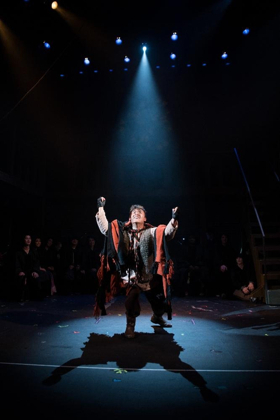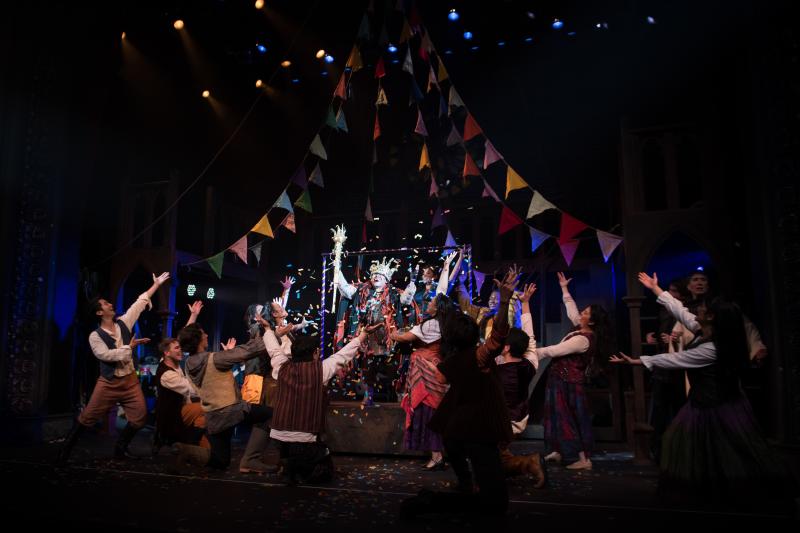Review: Bay Area Musical's THE HUNCHBACK OF NOTRE DAME is Glorious

Bay Area Musical's production of The Hunchback of Notre Dame came to glorious life on opening night in San Francisco's Victoria Theatre in the heart of the Mission district this past weekend. The show, written by Peter Parnell with music and lyrics by Alan Menken and Stephen Schwartz, is based on Victor Hugo's classic novel as well as the Disney animated film of the same name. This version of "Hunchback" debuted in 2015 and immediately labored under the heft and ubiquitous branding of the Disney animation, when in fact it is much more of a tragedy in the manner of Les Miserables. As such, The Hunchback of Notre Dame is a searing and evocative tour de force that didn't leave a dry eye in the house on opening night. Playing now through August 5, this professionally mounted production is an absolute must-see.
Victor Hugo penned his 940 page, 3-volume novel in 1831 largely to halt the demise of Paris' most treasured architectural masterpieces, most especially the Cathedral of Notre Dame. But over the decades, and in countless adaptations, the underlying themes of tolerance, sanctuary and true evil ("What makes a monster, and what makes a man?") ultimately came to the fore and made the story a classic. Sadly, the need for tolerance and sanctuary against true evil are as pressing today as they were when Hugo first wrote his masterpiece about the Gypsy outcast Esmeralda and Quasimodo, the doomed hunchback of Notre Dame.
Quasimodo is played by Alex Rodriguez in a seriously Tony-worthy performance, so honest and heart-wrenching is his portrayal. Donning the hump, his face smeared with mud, Rodriguez infuses the role with humble dignity and soulful singing, even as his Quasimodo prostrates himself in front of his uncle, Claude Frollo (a perfectly evil Clay David), the archdeacon of Notre Dame.
In the show's beginning exposition, the audience is told that Quasimodo's mother has died. His father, who is also dying, implores his brother to take the child as his own. The archdeacon is disgusted by his brother's unseemly life. He sees Quasimodo's deformity as the result of his parent's immorality, but nevertheless, he takes the child, hiding him away in the bell tower of the great cathedral. Quasimodo lives out his youth and young manhood there as the lonely bell ringer, with only the gargoyle statues on the parapet for friends. Verbally abused and relentlessly castigated by his uncle on daily basis, he believes himself to be the monster that his uncle tells him he is.
And yet, and yet, he hopes and dreams. In the anthem "Out There," Rodriguez's Quasimodo voices his desperate longing to leave his lonely tower and walk among the people - even if it's just for one day. When the vagabond Gypsies come into town to celebrate the yearly "Feast of Fools," a topsy-turvy festival where a commoner will be crowned the "King of Fools," Quasimodo sees his chance. Convinced by the Gargoyles to sneak out he makes his way down to the town square for the first time in his life.
It's there that he sees a beautiful Gypsy named Esmeralda (powerfully played by San Francisco native, Alysia Beltran). Esmeralda dances and entrances everyone around her, including Frollo and his newly appointed Cathedral Guard, Phoebus (the dashing Jack O'Reilly). When Esmeralda spots Quasimodo, she promptly pulls him up on stage and he is crowned the "King of Fools" by Trouillefou Clopin, the leader of the Gypsies. Branden Thomas is wonderful as Clopin, bringing a raffish humor and beguiling moxie to the role.
 Director, Choreographer and Scenic Designer Matthew McCoy creates a raucous scene of dancers and troubadours, as colorful flags get hoisted to the rafters and confetti careens to the ground. Sound (Anton Hedman) and Lights (Eric Johnson) effectively capture the mood here and throughout the show. And with half of the onstage orchestra stage left and the other half stage right, Music Director Jon Gallo (who seems to have his own cheering section) does a masterful job of conducting these splendid musicians.
Director, Choreographer and Scenic Designer Matthew McCoy creates a raucous scene of dancers and troubadours, as colorful flags get hoisted to the rafters and confetti careens to the ground. Sound (Anton Hedman) and Lights (Eric Johnson) effectively capture the mood here and throughout the show. And with half of the onstage orchestra stage left and the other half stage right, Music Director Jon Gallo (who seems to have his own cheering section) does a masterful job of conducting these splendid musicians.
As the captivating carnival continues the mood of the crowd suddenly shifts and they begin to taunt, belittle and attack Quasimodo. Esmeralda tries to save him but is chased away by Frollo's men. Phoebus moves to rescue him next but is stopped by the cruel Frollo, who wants Quasimodo to learn a lesson before he breaks up the crowd and takes his nephew back to the bell tower. Quasimodo is shaken as he recovers in Notre Dame but something in him has changed. A taste of freedom and the kindness of Esmeralda has awakened and emboldened him to want more for himself.
Esmeralda, who feels responsible for what happened to the Hunchback, heads to the Cathedral in search of her new friend. She's confronted by the archdeacon who is on his way to conduct Mass. It's clear that he wants her, but he masks his lust with pious dissembling, offering instead to save her soul. When she counters that her soul doesn't need saving, he tells her, "You can't right all the wrongs of this world by yourself, perhaps there's someone in here who can," before walking away. He's referring to himself, but she takes him to mean God.
In the most poignant moment in the story, Esmeralda's hurting heart compels her to look around the sanctuary and offer her own prayerful thoughts in song about the true meaning of being godly. Alysia Beltran's nuanced supplication on behalf of the outcasts was tender, sad and moving - especially when migrants are deemed outcasts even now - and often by those who should know better. After all, aren't we a country of immigrants?
Esmeralda sings, "God help the outcasts, hungry from birth, show them the mercy they don't find on earth," a searing indictment if there ever was one. It is no small thing that The Hunchback of Notre Dame references the Holy Family's flight across the border to Egypt more than once during the show. As James Carroll recently wrote in the New Yorker, "From the get-go, the Bible's God...stands with the victims not the victimizers....Those at the bottom want not love but justice-and the Bible offers it by seeing everything from below, from south to north."
Quasimodo, Esmeralda and even the Cathedral guard Phoebus, along with the rest of the Gypsies (the ensemble was stellar) all find themselves at the bottom of the power structure as Frollo determines to destroy the Gypsies and put Esmeralda to death. How Quasimodo finds the courage to rise up against Frollo is something you'll have to come see for yourself.
A word about the entire production and the Victoria Theatre. Typically, the term "attention to detail" is most often found on resumes, but this cast, crew, creative team and house staff's professional attention to detail added immeasurably to the theatrical experience. And the audience was to die for. The energy inside the Victoria theatre was positively electric.
Playing now through August 5, Bay Area Musical's The Hunchback of Notre Dame is a must-see tour-de-force. You'll kick yourself if you miss Alex Rodriguez and the rest of this stellar cast, so get your tickets ASAP.
In the program notes Artistic Director Matthew McCoy (is there nothing he can't do?) writes of his hope that you leave the show "having an open mind of love, acceptance, and empathy for everyone you come into contact with." In this classic tale of humanity's inhumanity, written so long ago, the question is: When will that change for good?
THE HUNCHBACK OF NOTRE DAME
Bay Area Musicals at the Victoria Theatre
Now thru August 5
www.bamsf.org
Book by Peter Parnell
Music by Alan Menken
Lyrics by Stephen Schwartz
Direction and Choreography by Matthew McCoy
Musical Direction by Jon Gallo
Join @bayareamusicals in their call to speak up for the outcasts with #sanctuary and #hunchbacksf.
Reader Reviews
Videos

